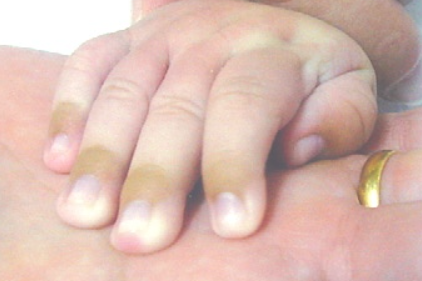Acromelanosis progressiva is a rare pediatric dermatosis characterized by hyperpigmentation of the skin of the acral areas of the hands and feet. ICD-10 Code: L81.9.
This condition occurs in newborns and children up to 1-2 years of age. The prevalence is unknown and only a few cases have been reported. Etiology and pathogenesis are not well understood. It occurs sporadically, but may be inherited as an autosomal recessive trait. Some believe that the condition may be an epidermal melanocytic hamartoma (epidermal melanocytosis).The disease begins with the appearance of light brown patches on the surface of the fingers of the hands and/or feet, less commonly on the palms, soles, and perianal area. Later, after several weeks or even years, the thighs, buttocks, genital area, groin, abdomen, head, and neck may be affected.
The border between hyperpigmented patches and normal skin is often very distinct. Affected areas may range in color from brown to bluish-black, especially on the fingers. Involvement of the oral mucosa has been reported. Nails are not affected.
There are no subjective symptoms. With age, the process stabilizes, but spontaneous resolution of the eruptions is not observed. An association with malignant neoplasms such as Wilms' tumor has been suggested.- Periungual hyperpigmentation in newborns.
- Addison's disease.
- Dyschromatosis symmetrica hereditaria (Reticulate acropigmentation of Dohi)
- Reticulate acropigmentation of Kitamura.

